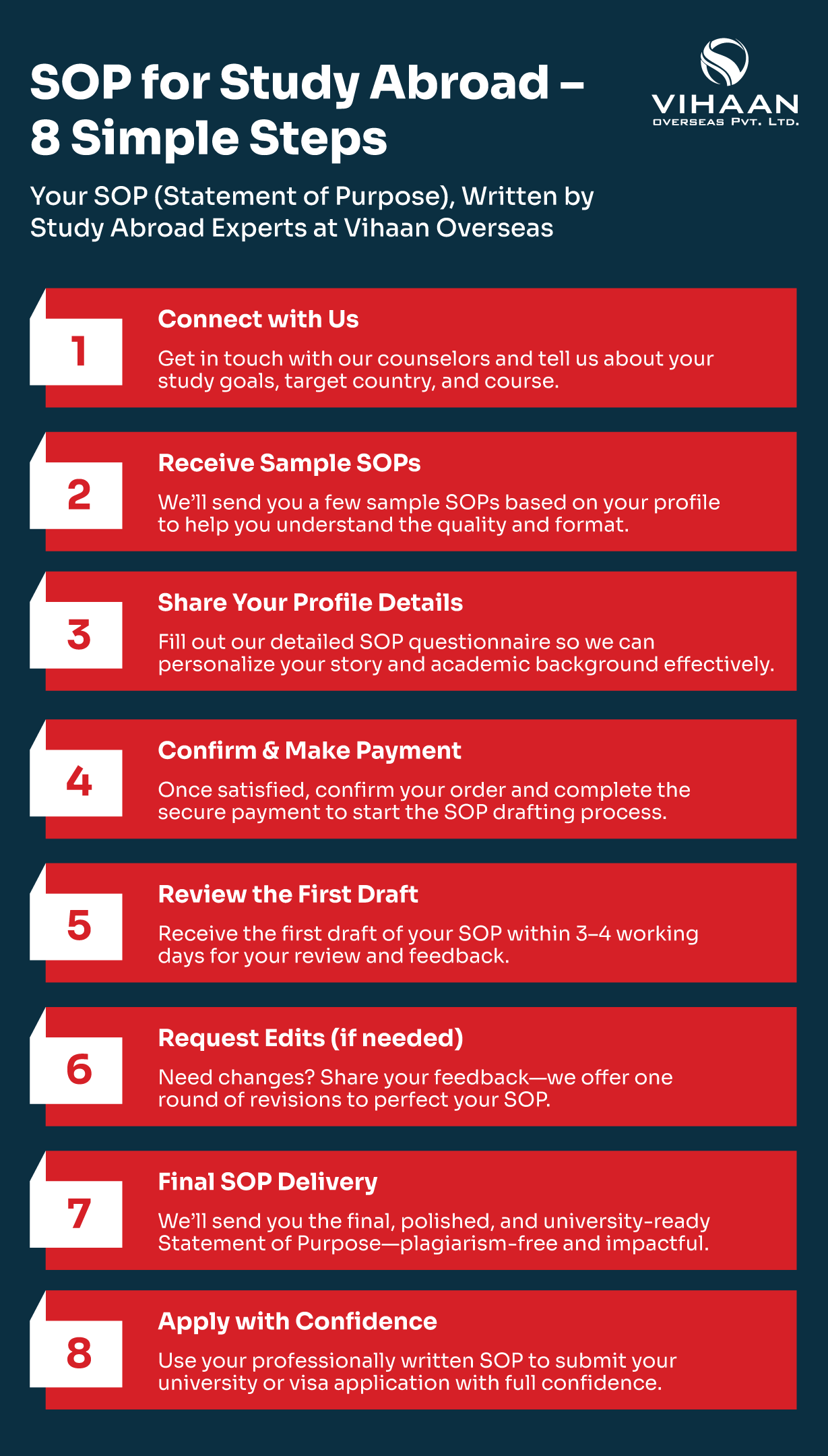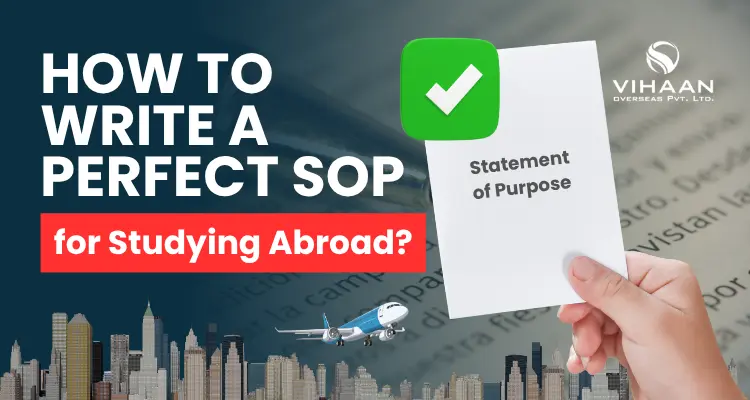
Top 7 Mistakes Students Make While Applying to Study Abroad & How to Avoid Them
June 12, 2025
Advanced Strategies to Write an SOP for Studying Abroad
July 24, 2025A perfect SOP for studying abroad should tell your unique story in 800-1000 words, clearly explaining why you want to study your chosen course, why you picked that specific university and country, and how this fits your career goals. It should be personal, honest, and well-structured with a compelling introduction, detailed body, and strong conclusion.
Are you dreaming of studying in your favorite country but feeling overwhelmed about writing your Statement of Purpose? Don't worry – you're not alone! Every year, thousands of students struggle with creating a winning SOP that opens doors to their dream universities.
This comprehensive guide will walk you through everything you need to know about writing a perfect SOP for study abroad, from understanding the basics to avoiding common mistakes.
What is an SOP for Studying Abroad?
A Statement of Purpose (SOP) for studying abroad is a personal essay that explains why you want to pursue higher education in a foreign country. Think of it as your chance to have a conversation with the admissions committee about your dreams, goals, and motivations.
Unlike academic transcripts or test scores, your SOP shows who you are as a person. It's where you can share your story, explain your passion for your chosen field, and convince the university that you're the right fit for their program.
Key purposes of an SOP:
- Demonstrates your writing skills and English proficiency
- Shows your genuine interest in the course and university
- Explains your academic and career goals
- Highlights your unique experiences and achievements
- Proves you're serious about studying abroad
Most universities consider the SOP as one of the most important parts of your application, sometimes even more than your grades!
Why Do You Need an SOP for Studying Abroad?
Your SOP for international students serves multiple crucial purposes that can make or break your study abroad dreams.
- For University Admissions: Universities receive thousands of applications from students with similar grades and test scores. Your SOP is what makes you stand out from the crowd. It helps admissions officers understand your personality, motivations, and potential contribution to their campus community.
- For Visa Applications: Many countries require an SOP as part of the student visa application process. Visa officers use it to assess whether you're a genuine student with clear academic goals or someone who might misuse the student visa.
- For Scholarship Applications: If you're applying for scholarships, a compelling SOP can significantly increase your chances of receiving financial aid. Scholarship committees want to invest in students who have clear goals and strong motivation.
What to Include in a Strong SOP for Study Abroad?
Every perfect SOP for study abroad must include five essential elements: your academic background, career goals, reasons for choosing the specific course and university, personal motivation, and relevant experiences.
Academic Background and Achievements
Start by presenting your educational journey and academic accomplishments. Clearly mention:
- Your current qualifications and academic performance
- Relevant projects, internships, or research work
- Scholarships, awards, or academic recognitions
- Why you chose your undergraduate discipline
- Key skills and knowledge acquired during your studies
Career Goals and Future Plans
Admissions officers look for students with a clear sense of direction. Make sure you include:
- Your short-term plans after completing the course
- How the course aligns with your professional path
- Your long-term career goals (5–10 years down the line)
- How studying abroad will help you reach those goals
- How you plan to contribute to your home country or industry
Why This Course and University?
This section often plays a decisive role in your admission. Be specific about:
- Why you're interested in this particular course or specialization
- How the curriculum fits your academic and career goals
- Specific modules, research areas, or professors you admire
- Unique resources, facilities, or industry connections of the university
- The institution’s global or regional reputation in your field
Personal Motivation and Story
Let your SOP reflect your passion and personal journey. Consider including:
- What inspired your interest in the subject area?
- Challenges you've overcome that shaped your determination
- Life events or experiences that influenced your academic path
- Your enthusiasm for learning and contributing to the field
Extracurricular Activities and Skills
Show that you’re a well-rounded candidate beyond academics:
- Leadership roles in school, college, or social settings
- Volunteer work or community involvement
- Relevant work experience or internships
- Technical or soft skills, certifications, or achievements
- Hobbies that reflect discipline, creativity, or leadership
Recommended Word Count Distribution
Here’s how you can structure your SOP for a balanced and effective flow:
- Introduction: 10–15% of total word count
- Academic Background: 25–30%
- Course and University Fit: 25–30%
- Career Goals: 20–25%
- Conclusion: 10–15%
Step-by-Step Guide to Writing Your Perfect SOP
How do I write a great statement of purpose for a foreign university? Follow this proven 5-step process: Research thoroughly, create a detailed outline, write your first draft, review and refine multiple times, then polish for final submission.
Step 1: Research Before You Write
Before you start writing, invest time in thorough research:
- Study the university website, course curriculum, and faculty profiles
- Understand the specific admission requirements and expectations
- Check the SOP word limit (typically ranges from 500 to 1000 words)
- Read sample SOPs from successful applicants to your target universities
- Research the country's education system and cultural values
Step 2: Create Your SOP Outline
Introduction (100-150 words):
- Start with an engaging hook that captures attention
- Briefly introduce yourself and your academic background
- Clearly state your intended course and target university
- Preview what the reader will learn about you
Body Paragraph 1 - Academic Journey (150-200 words):
- Discuss your educational background and key achievements
- Highlight relevant coursework, projects, or research experience
- Connect your past academic choices to your future goals
- Mention any academic challenges you've overcome
Body Paragraph 2 - Why This Course? (150-200 words):
- Explain your specific interest in this program
- Reference particular modules, research areas, or methodologies
- Show that you understand what the course involves
- Connect the curriculum to your career aspirations
Body Paragraph 3 - Why This University? (100-150 words):
- Demonstrate detailed knowledge about the institution
- Mention specific facilities, professors, research groups, or opportunities
- Explain how the university's environment and culture suit your learning style
- Reference the university's reputation or unique strengths
Body Paragraph 4 - Career Goals (150-200 words):
- Outline your short-term objectives (immediately after graduation)
- Describe your long-term career vision (5-10 years ahead)
- Explain how this course will bridge the gap between where you are and where you want to be
- Discuss your potential contributions to society or your industry
Conclusion (100-150 words):
- Summarize your key motivations and qualifications
- Reaffirm your commitment to the program and university
- End with confidence and enthusiasm about your future
- Express gratitude for the committee's consideration
Step 3: Write Your First Draft
Focus on getting your ideas down on paper:
- Use simple, clear language that sounds natural
- Write in active voice to make your writing more engaging
- Keep sentences concise and easy to follow
- Be honest and authentic - let your personality shine through
- Don't worry about perfection in the first draft
Step 4: Review and Refine
Take time to improve your content systematically:
- Check for grammatical errors and spelling mistakes
- Ensure smooth transitions and logical flow between paragraphs
- Verify all facts, figures, and university-specific information
- Remove any generic statements that could apply to any university
- Get feedback from teachers, mentors, or experienced counselors
Step 5: Final Polish
Prepare your SOP for submission:
- Read your SOP aloud to check the natural flow
- Ensure you're within the specified word limit
- Format according to university guidelines (font, spacing, margins)
- Save multiple versions and backup copies
- Double-check university names and course titles for accuracy

SOP Checklist: Final Review Before Submission
Essential SOP review checklist: Before submitting your SOP, verify content completeness, technical accuracy, formatting consistency, and authentic voice. This systematic review ensures your application meets all requirements and maximizes your chances of acceptance.
Content Review Checklist
Introduction and Opening:
- Engaging hook that captures attention immediately
- Clear mention of intended course and university
- Brief preview of your qualifications and motivations
- Authentic voice that sounds like you
Academic Background Section:
- Specific academic achievements and grades mentioned
- Relevant coursework, projects, or research highlighted
- Connection between past studies and future goals
- Any academic challenges addressed positively
Course and University Fit:
- Specific reasons for choosing this particular program
- Mention of particular modules, professors, or facilities
- Demonstration of thorough research about the institution
- Clear connection between program features and your goals
Career Goals Section:
- Realistic short-term objectives (post-graduation)
- Well-defined long-term career vision
- Clear explanation of how the course supports these goals
- Potential contribution to industry or society mentioned
Personal Motivation:
- Authentic personal experiences that shaped your interests
- Challenges overcome that demonstrate resilience
- Passion for the subject clearly communicated
- Unique perspective or background highlighted
Conclusion:
- Strong, confident closing statement
- Reaffirmation of commitment to the program
- Expression of enthusiasm about contributing to university community
- Appropriate gratitude for committee's consideration
Technical Review Checklist
Word Count and Format:
- Total word count within specified limits (usually 500-1000 words)
- Proper font (typically Times New Roman 12pt)
- Correct spacing (usually double-spaced)
- Appropriate margins (typically 1 inch on all sides)
- Professional formatting throughout
Language Quality:
- No grammatical errors or typos
- Consistent verb tenses throughout
- Clear, concise sentence structure
- Active voice used predominantly
- Appropriate academic tone maintained
Accuracy Check:
- University name spelled correctly everywhere
- Course title mentioned accurately
- Professor names and research areas verified
- All facts and figures double-checked
- Dates and timelines accurate
Final Quality Assessment
Authenticity and Voice:
- Sounds genuinely like your personality and perspective
- Avoids clichés and overused phrases
- Demonstrates genuine interest rather than generic enthusiasm
- Shows deep research about the university and program
- Maintains positive, confident tone throughout
Uniqueness and Customization:
- Clearly customized for this specific university
- Cannot be easily adapted for other institutions
- Shows understanding of what makes this program special
- Addresses university's specific values or culture
- Demonstrates fit with institutional goals
Overall Impact:
- Creates a memorable impression of you as a candidate
- Tells a coherent story from past experiences to future goals
- Balances academic achievements with personal growth
- Shows maturity and readiness for graduate study
- Convinces readers that you'll succeed in their program
Pre-Submission Final Steps
File Management:
- Saved in required format (PDF or Word as specified)
- File named appropriately (usually LastName_FirstName_SOP)
- Multiple backup copies created and stored safely
- Version control maintained (avoid submitting wrong draft)
Submission Process:
- Application portal requirements reviewed carefully
- Submission deadline confirmed and calendar reminder set
- All other application materials prepared and ready
- Contact information verified in case of technical issues
Professional Review Consideration: Consider getting your SOP reviewed by experienced counselors at Vihaan Overseas for expert feedback, suggestions, and final polish before submission. Sometimes an outside perspective can identify improvements you might miss.
Conclusion
Writing a perfect SOP requires careful planning, honest reflection, and skilled execution. Your SOP is your opportunity to show admissions officers who you are beyond grades and test scores. The key lies in telling your unique story authentically while demonstrating clear goals and genuine program interest.
Ready to start your study abroad journey? At Vihaan Overseas, our IDP-certified counselors have helped thousands craft winning SOPs with over 5,200 visa approvals and a 97% success rate. We provide comprehensive support from SOP writing to visa guidance.
Contact Vihaan Overseas today to speak with our expert counselors. Don't let a poorly written SOP stand between you and your dreams – your study abroad success story starts with a perfect SOP.

















